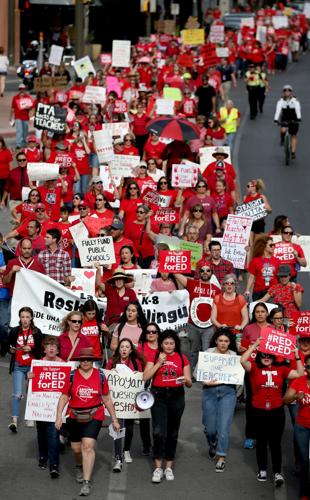The relief and excitement were palpable Thursday after Gov. Doug Ducey announced his discovery of enough money to give Arizona teachers raises previously declared impossible.
Suddenly, a strike didn’t seem inevitable, and raises did. A miracle!
Ducey’s supporters — who just days before were arguing variously that there was no more money, that it isn’t the governor’s job to set teacher pay, and that the teachers’ movement is just a Democratic Party proxy — immediately embraced the governor’s plan to meet the movement about halfway in their wage demands.
“We really do have the best Governor in the country here in Arizona,” Brandy Wells, vice president of the Arizona Chamber of Commerce and Industry, said via Twitter. “@dougducey’s work and convening of decision makers on the teacher pay issue, without raising taxes, was incredible. RE-ELECT THIS MAN! #azawesome #realleadership”
This was echoed throughout Arizona’s conservosphere as Ducey responded to the teachers’ movement’s demands: Wow! Visionary! Leadership! Re-elect!
More surprisingly, allies of the movement also joined in immediate support. Members of Save Our Schools Arizona — the group that has successfully fought a new voucher program that Ducey supports, putting it on the state ballot — the Arizona School Board Association and the Arizona PTA stood onstage with Ducey as he made his announcement.
It suffices to say they didn’t know any of the details of what Ducey was proposing, only the rough outline. A 9 percent raise this year, on top of an existing 1 percent proposed raise, plus 5 percent each of the next two years. The governor’s team already had a nifty slogan and hashtag — 20 percent by 2020, or #20x2020.
Everybody is right that the governor’s announcement was hopeful news, but this is no time for teachers or the #RedForEd movement to declare victory and stash away their crimson shirts. The only thing that has gotten them this far is collective action and increasing pressure. They cornered the governor in an election year, and they shouldn’t let him out till they’ve got their raises and increased school funding in hand.
It’s useful to recall how we got here. For 10 years, the state has been severely underfunding public education. Ducey himself contributed to this when, as state treasurer, he led the campaign against Proposition 204, which would have maintained and increased a state sales tax benefiting K-12 education. He said we didn’t need the money but just needed to spend more effectively.
Then Ducey negotiated a settlement of a lawsuit over the state’s underfunding of education. Teachers and school boards agreed to push for Prop. 123 even though the measure settled the lawsuit by giving them 70 cents on the dollar owed. The winning logic was that passing the proposition beat fighting in court for years.
Some additional money has been flowing, but not enough. Gradually, Arizona’s teachers voted with their feet, leaving the profession or the state, or both. The crisis could not be denied, but it still had to be converted into a movement. The successful West Virginia teachers strike, which ended March 6, did that.
In early March, the Arizona Educators United Facebook page was established and teachers started wearing red as a symbol of their movement. On March 28, the movement leaders announced their demands — a 20 percent increase in pay and a restoration of $1 billion in lost education funding. On Wednesday last week, teachers across the state wore red and walked in to school together. Strike talk was growing.
As their momentum built, the Ducey administration and state Republicans began questioning the movement’s origin. Was it really the work of outside agitators? Was a strike itself the actual aim, not just the means to an end? Wasn’t it all just an effort to get Democrats elected in November?
Ducey voiced these suspicions during an interview Tuesday on KTAR radio, held as teachers protested outside. He referred to the movement as “political theater” and declined a request to meet with leaders of the teachers’ movement. “Why would I want to sit down with someone who wants to play politics?” he asked, as if the governor himself were not a political animal.
Instead he met with people he termed “decision makers” — notably, superintendents. The leadership of the rank and file was deemed too political. Noah Karvelis, a leader of the Arizona Educators United group, is the campaign manager for Kathy Hoffman, a Democratic candidate for state superintendent of public instruction. Joe Thomas, president of the Arizona Education Association, had endorsed a Democratic challenger for the governorship, David Garcia.
And yet, when Thursday arrived, it was clear who had the upper hand. Ducey and House Speaker J.D. Mesnard scrambled to put together plans to increase funding for schools and pay for teachers.
Ducey’s dramatic announcement was a great relief, but it was just words. It was a proposal to use money of unclear origin to raise the pay for teachers but not other employees like counselors and teachers’ aides. It’s a good gesture, but so far nothing more.
Arizona may not be used to social movements like #RedForEd. People may think that once the governor makes a partial concession, the movement ends. That would be ridiculous. Nothing has changed yet, just a change in the posture of the governing party in response to the movement’s popularity.
You don’t take the pressure off any more than a boxer with his opponent on the ropes would decide to go back to his corner and sit on his stool. You fight till you win the pay and funding increases you’re fighting for. That hasn’t happened yet.





